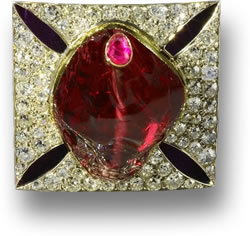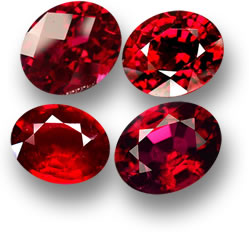|
|
Your Details
|
|
Your Details
|
Reviewed By Andreas Zabczyk
The Black Prince's Ruby : Famous Royal Jewels The Black Prince's Ruby
The Black Prince's Ruby is perhaps one of the most famous gems of all the British Crown jewels. Despite its name, the stone is neither black, nor is it a ruby, which is possibly why the stone has become so well known. The Black Prince's Ruby is actually a glowing red uncut spinel which has been owned by the British Royal Family since 1367. The gem was named after the 'Black Prince', Edward of Woodstock, Prince of Wales, and is one of the oldest of gems included in the Royal Collection of Crown Jewels. It currently sits in the cross pattee at the front of the Imperial State Crown, just above the Lesser Star of Africa, also known as The Cullinan II, one the largest polished diamonds in the world. Fine red spinel is actually considered to be rarer than ruby in occurrence and can often be even more valuable. The Black Prince's Ruby is the one of the world's largest uncut red spinel gems, with an estimated weight of 170 carats and a length of almost 5 centimeters. The Black Prince's Ruby is slightly polished to bring out its luster and has been worked into a bead shape. It was previously drilled, strung and worn as a pendant and various other forms of jewelry before being placed in the Imperial Crown where it can be seen today. Through close observation, it can be seen that the small drilled hole has been plugged with a smaller ruby. For most of time, all red transparent gemstones were simply thought to be 'rubies', which is why the royal gem was thought to be a ruby for centuries. It was only through the technological advancement of mineral studies that the Black Prince's Spinel was actually discovered to be red spinel. Spinel and ruby do share many similar physical traits, but ruby (corundum) can be distinguished based on its hardness and density. Ruby is slightly harder and denser than spinel. Ruby is also dichroic like most other gemstones, whereas spinel is singly refractive; an optical property that is actually quite rare and a trait found only in a few well-known gem types, including diamond and garnet.  Ruby-Red Loose Spinel Gemstones
The Black Prince's Ruby was originally believed to have belonged to Prince Abu Sa'id of the Moorish Kingdom of Granada sometime during the 14th century. It was thought to have been mined somewere from present-day Tajikistan, which was then known as Badakshan. At that time, Don Pedro the Cruel, ruler of Castile, was overtaking Granada, the last Muslim outpost in Spain, as part of his Christian Reconquest. During this time, the rule of Castile was being centralized to Spain. According to historical records, Prince Sa'id was planning to surrender to King Don Pedro, but Pedro had other plans, which earned him his 'Cruel' nickname. Don Pedro welcomed Prince Abu Sa'id and his servants to Seville to discuss the terms of his surrender, but the Moorish Prince's servants were killed and Don Pedro may have personally stabbed Abu Sa'id. Don Pedro acquired Abu Sa'id's wealth upon his death, and after searching his body, Don Pedro discovered the large red gemstone and added it to his own possessions. It is said that the gruesome murder of the Prince sparked a curse that would follow Don Pedro from that day on. The curse was said to have brought misfortune or even death to those who owned the "Black Prince's Ruby". Shortly after Don Pedro acquired the gem from Abu Sa'id, his half-brother, Henry of Trastamara declared war on Castile for the right to rule. The revolt led Don Pedro to forge an alliance with Prince Edward III, known as 'the Black Prince' of England. Edward was a great knight, but during medieval times, even great knights were in war for profits and not just chivalry. The Black Prince successfully defeated Henry of Trastamara, and promptly demanded the gemstone from Don Pedro as payment in exchange for his alliance. The Black Prince brought the jewel back to England where it has remained ever since, although it has not been mentioned in recorded history since some time around the 1400s. |
